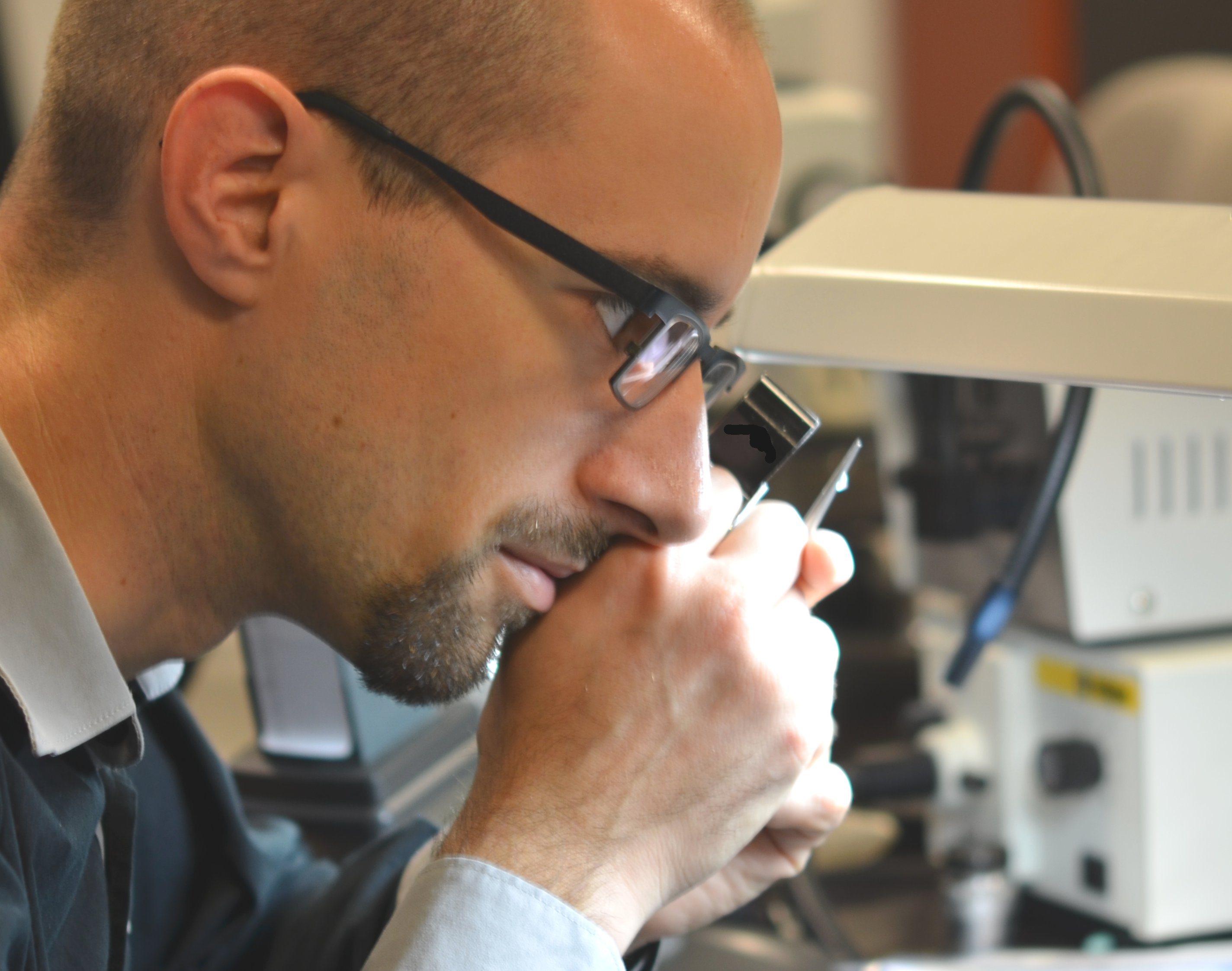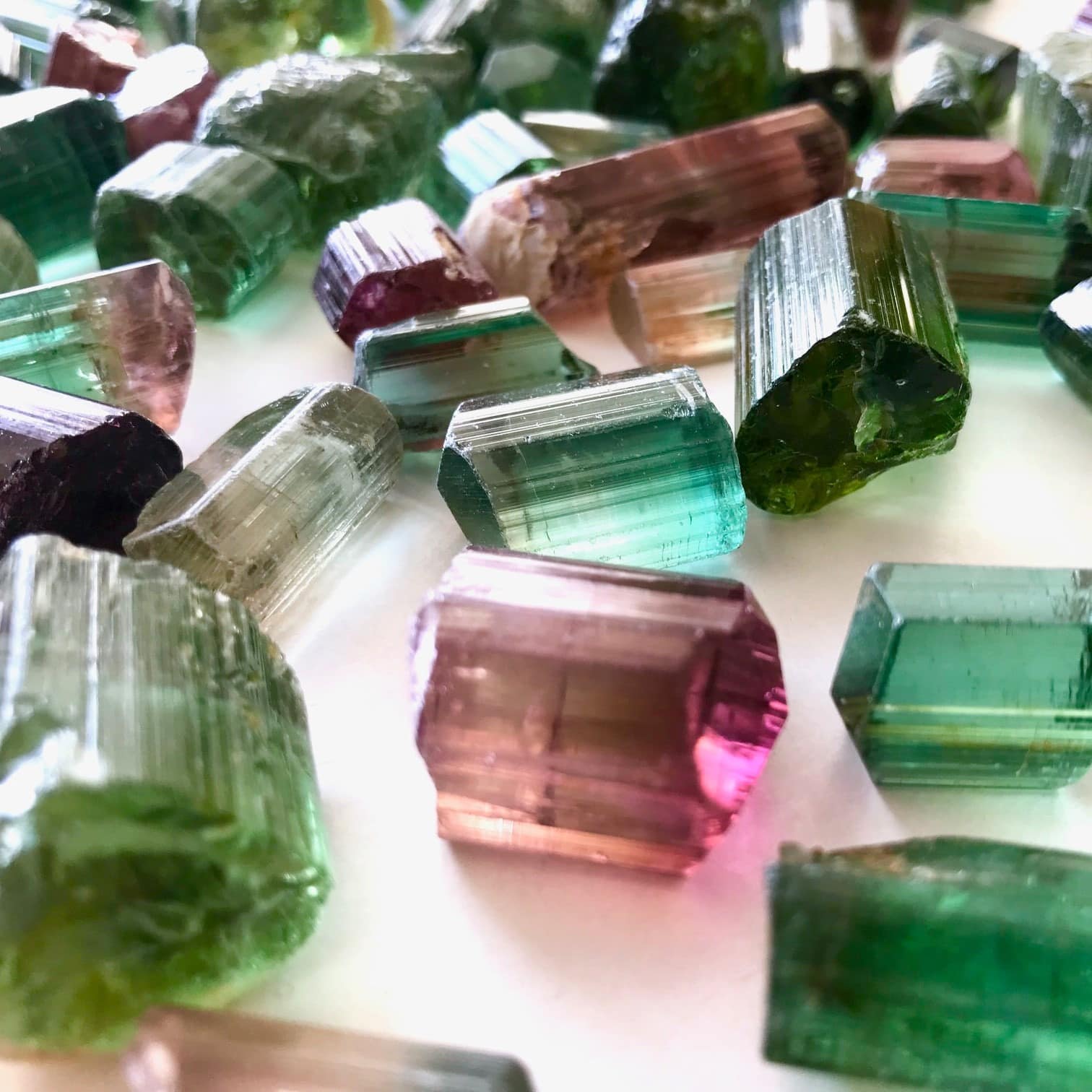For this second career interview, I went to meet Aurélien Delaunay who works as a gemmologist at the Laboratoire Français de Gemmologie. With kindness and patience, he lent himself to the game of questions and answers for this new professional interview. A huge thank you to him!
 Examination of a diamond with a magnifying glass. Photo: LFG
Examination of a diamond with a magnifying glass. Photo: LFG
- Aurélien, can you introduce yourself quickly?
My name is Aurélien Delaunay, I am 32 years old and I come from the Anjou vineyards.
- What profession did you want to do when you were a child?
I wanted to be an archaeologist and to be like Indiana Jones. But when someone told me that I had to do a literary section, I backed off and went into geology.
- And finally, what is your job today?
I am a gemmologist, in charge of a laboratory and more specifically of the “Diamonds” department at the Laboratoire Français de Gemmologie (LFG).
- Can you tell us about your initial studies?
After a scientific baccalaureate, I studied geology, Earth and Universe sciences at the University of Angers and then at the University of Nantes where I obtained a Master 2 in Planetary Geosciences.
- When did you first become interested in gems?
I have been passionate about them since childhood. I was already attracted by stones, I used to collect a lot of stones that I found pretty on the beaches or in the country lanes. Then the question of professional orientation came up. In secondary school, there was a forum on careers organised. My father, who worked at the town hall, knew that there was someone in the commune who had a job related to stones. I sent him a letter asking him if he wanted to come and talk about his job. Pascal Entremont, Stone Hunter, was abroad at the time and could not come. But he invited me to meet him at his place. As we have common passions, we got on well. He explained the profession to me, advised me to study geology in Angers and then to continue my studies in Nantes, the centre of gemmology, where I was to meet his friends (who also became mine), professors Bernard Lasnier and Emmanuel Fritsch.
- And what specific training course in gemmology did you follow?
I followed the University Diploma of Gemmology in Nantes while training in classical gemmology in a self-taught way. My thesis was on“Hydrogen in diamonds and the study of a fibrous diamond”. There are many informative supports on gemmology (books, internet, forum, etc.). Then I had to pass the diploma of the National Institute of Gemmology in order to work there.
- Gemstones are not really found in France. Have you travelled?
I have travelled but not especially to find stones. Afterwards, I always bring back a piece of stone (if it is allowed) even if it is not a precious stone. But I have found some interesting things in France that can be shaped: trapiche sapphire, quartz in Brittany, chiastolite, garnets, etc. For the rest, I travel a lot thanks to museums.
- Let’s get to the heart of the matter: tell us about your workplace and how it works? Can you tell us a bit about your team?
I work at the Laboratoire Français de Gemmologie, the oldest gemmological laboratory in the world. Created in 1929 at the request of the profession, its aim is to analyse all gem materials. It is the most important French laboratory that issues scientific analysis reports on precious stones (diamonds, rubies, sapphires, emeralds, etc.) and pearls. These gems can be deposited by various professional or private clients. We are a team of a few gemologists, some of them with marked specialisations on diamonds, coloured stones or pearls. We also have people who take care of the administrative side of things.
- How did you get to this position? Tell us about your career path.
My career path, like my training path, is based on encounters. Those moments that make you take this or that path. After finishing my university training in gemmology, I stayed longer at the university to work on my thesis. There was a thesis defence the following week and one of the jury members, the director of the LFG at the time, needed a little help due to an increased demand for diamond reports. I was there at the right time and stayed at the LFG for almost a year grading diamonds. Then I went to teach gemmology at the National Gemmological Institute where I was responsible for the collection and the scientific content of the courses. For two years I tried to bring as much as possible to this school. In 2011, the LFG was bought by the Union Française BJOP, I was contacted by Professor Emmanuel Fritsch who is scientific advisor at the LFG because they were looking for someone who could take care of diamonds. I applied, they had my CV, they knew me and everything was done in a few minutes. Since then, the LFG has evolved, a lot of equipment has been bought, a new competent team has been put in place. Today, the LFG follows strict scientific procedures that strengthen its foundations and only reinforce its place as a reference in the field.
- Let’s talk about your work, what does a typical working day/week look like?
I focus on the smooth running of the laboratory. Specifically, I grade the diamonds submitted for colour, clarity, size, and I run a battery of tests to ensure that they are not synthetic or treated. Sometimes, some diamonds are more problematic and I may spend more time researching to find differentiation criteria.
Secondly, I may work on coloured stones or pearls if the workload is high in these departments.
Finally, I ensure the smooth running of the laboratory by validating all the analyses and reports issued.
- What do you like best about your job?
Every stone is different, so there are many ways to like them. Let’s just say that researching whether a stone is synthetic and/or treated is fascinating. It’s like playing detective every time.
- What are the more negative or annoying aspects?
The most annoying aspect, if there is one, is perhaps the repetition of tasks when you are grading many diamonds in a row.
- Is it a stressful job?
It’s quite a stressful job because there are so many things at stake. Clients are often in a hurry, which means we have to work fast and well. This ‘speed’ is a risk that we try to minimise as much as possible by taking the time to analyse and explaining to the client why we need extra time on certain stones.
- There are certainly aspects that the general public does not realise?
We have a passion for our work, but the scientific and rigorous aspect is essential. An analysis is generally not done in 5 minutes and we must, each time we give a result, have proof of what we are saying. We have the chance to analyse wonders of nature as well as small, unattractive stones.
- Analysing stones sometimes means disappointing people. How do we deal with this?
We are human beings, we are always saddened by certain cases. Afterwards, we must remain professional because our analysis is professional. We have to try to put all this aside. As gemmologists, we do not know the history of the stone or its owner. For us, it is only a number.
- When you talk about an expert’s laboratory, you may find yourself involved in legal disputes one day. Are you thinking about this? Are you preparing for this type of eventuality?
Yes, that’s why all the results we produce are based on scientific expertise. We have scientific evidence to prove our analysis result. These analyses can be “given” to the client as part of a substantiated report.
- How do you see your daily work?
Like a new investigation with every stone, fun.
- You work with a varied clientele: private individuals, large houses, independent jewellers… I suppose that the relationships are different. How do you manage the level of demand of each one?
Each client has a different level of demand. Our level of requirement in the analysis is the same for all. After that, we try to listen to our clients as much as possible.
- The LFG offers gemmology training. Do you give courses? Do you like to pass on your knowledge and teach/ write?
The LFG has always been involved in the transmission of knowledge since its creation in 1929. It continues to pass on its knowledge thanks to the new gemmology training centre opened a few years ago. Having given courses at the National Gemmological Institute, it is with pleasure that I continue to teach on topics such as diamonds and geology. It is always a pleasure to share knowledge in training or through scientific articles.
- Synthetic diamonds are increasingly present on the market. Can we say that managing its presence on the market is the challenge of the years to come?
Synthetic diamonds are becoming increasingly ‘easy’ to manufacture. Scientific advances in the field have made the growth of diamonds in the laboratory ‘known’ and less and less expensive. Synthetic diamonds are currently breaking records for weight, colour, etc. In a few years, we can expect to see more and more of them, especially in lots of small stones.
- Do you have a story to tell us?
There are many. A recent one: I was going home one evening by metro when I saw a few pearls rolling around in the metro. Every time the train accelerated or braked, I could see them rolling back and forth. I caught some of them, they were quite pretty cultured pearls. One necklace must have broken.
- So how do you relax when you have such a busy job?
You try to spend time doing other things: spending time with your family, taking up hobbies, etc.
- And do you really give up?
Not really, in fact, because we are now connected 24 hours a day, 7 days a week. The friends we have are often people from the profession, so when we spend time with friends, we often talk about the profession. And as a scientist, you have to keep a constant watch on the advances in our sector. Researchers are moving very fast in the synthesis or treatment of gems. We have to keep abreast of all these advances.
- And in the future, how and where do you see yourself?
It’s hard to say, but as long as everything is going well and I’m enjoying what I do, there’s no reason for me to change jobs.








